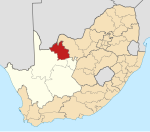
Kathu is a town in South Africa, and the iron ore capital of the Northern Cape province. Its name means "town under the trees", after the Camel Thorn forest it is situated in. The phrase "the town under the trees" was coined by an engineer working in the town in the early-1990s as part of a tourist marketing drive, together with the accompanying graphic. It was intended to be a marketing slogan. The meaning of the word "Kathu" has anecdotically been attributed to a porridge brewed by the local population from the powder found in the pods of the Camel Thorn trees.

Thabazimbi is an iron mining town in the Limpopo province of South Africa. The town is at the feet of the Ysterberg and is surrounded by the Witfonteinrand and Boshofberg with the majestic Kransberg in the background. The name Thabazimbi means mountain of iron because of the large iron ore reef that was discovered in 1919 by J. H. Williams. The mine boasts one of the largest mining shafts in Africa. More than 2 million tons of ore are mined every year and hauled by train to Mittal's iron and steel works. The railway line from Rustenburg reached the area in the 1930s and full scale iron and steel production began. The town was proclaimed in 1953. Kumba Iron Ore, previously Kumba Resources, is now the principal operator of the iron ore mine.

Saldanha Bay is a natural harbour on the south-western coast of South Africa. The town that developed on the northern shore of the bay, also called Saldanha, was incorporated with five other towns into the Saldanha Bay Local Municipality in 2000. The current population of the municipality is estimated at 72,000.

Transnet Freight Rail is a South African rail transport company, formerly known as Spoornet. It was part of the South African Railways and Harbours Administration, a state-controlled organisation that employed hundreds of thousands of people for decades from the first half of the 20th century and was widely referred to by the initials SAR&H. Customer complaints about serious problems with Transnet Freight Rail's service were reported in 2010. Its head office is in Inyanda House in Parktown, Johannesburg.

Exxaro Resources is a large coal and heavy minerals mining company in South Africa. The company operates facilities and offices in Africa, Asia, Europe and Australia. The company is listed on the Johannesburg Stock Exchange and at 31 December 2016, had assets of R59.931 billion and a market capitalisation of R32.05 billion.
Iron ore production in Africa is dominated by South Africa, Mauritania and Algeria. Many countries possess iron ore deposits that are as yet untapped/unmined. Countries and companies currently involved in production are listed here; measurements are in tonnes per annum(year).

The length of a train may be measured in number of wagons or in metres for general freight. Train lengths and loads on electrified railways, especially lower voltage 3000 V DC and 1500 V DC, are limited by traction power considerations. Drawgear and couplings can be a limiting factor, tied in with curves, gradients and crossing loop lengths.

The Sishen–Saldanha railway line, also known as the Ore Export Line (OREX), is an 861-kilometre-long (535 mi) heavy-haul railway line in South Africa. It connects iron ore mines near Sishen in the Northern Cape with the port at Saldanha Bay in the Western Cape. It is used primarily to transport iron ore and does not carry passenger traffic.
Kumba Iron Ore is an iron-ore mining company in South Africa. It is the fourth largest iron-ore producer in the world and the largest in Africa.

Saldanha, also known as Saldanha Bay, is a town of 21,636 people, located 110 kilometres (70 mi) north of Cape Town on the northern shore of Saldanha Bay, in the Western Cape province of South Africa. Its situation as a natural sheltered harbour has led to development as a port for the export of iron ore from Sishen in the Northern Cape, which is transported on the Sishen–Saldanha railway line. The port is one of the largest exporting ports of ore in the whole of Africa, and it is able to handle ships as large as 200 000 tons deadweight.

The Transnet Freight Rail Class 15E of 2010 is a South African electric locomotive.

The South African Railways Class 9E, Series 1 of 1978 is an electric locomotive.

The South African Railways Class 9E, Series 2 of 1982 is an electric locomotive.

The South African Railways Class 33-400 of 1968 was a South African and Namibian diesel-electric locomotive.

The South African Railways Class 34-000 of 1971 is a diesel-electric locomotive.

The South African Railways Class 34-400 of 1973 is a diesel-electric locomotive.

The South African Railways Class 34-500 of 1974 is a diesel-electric locomotive.

The South African Railways Class 34–900 of 1980 is a diesel-electric locomotive.

The Transnet Freight Rail Class 43-000 of 2011 is a South African diesel-electric locomotive.
The Sishen mine is a large iron mine located in central South Africa in Kathu, Northern Cape. Sishen represents one of the largest iron ore reserves in South Africa and in the world having estimated reserves of 2.43 billion tonnes of ore grading 58.6% iron metal.



















